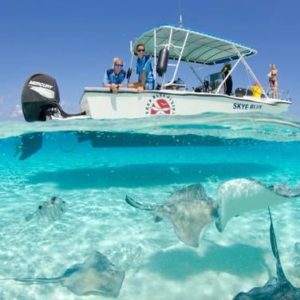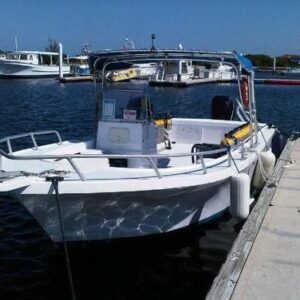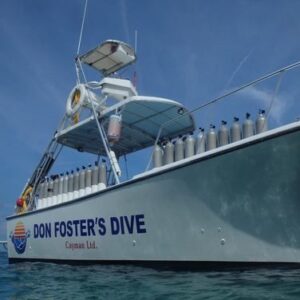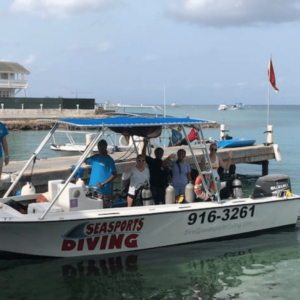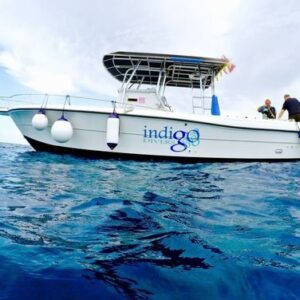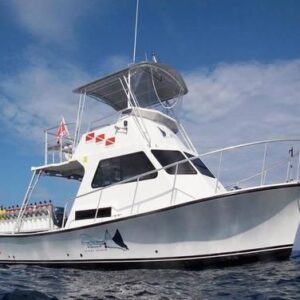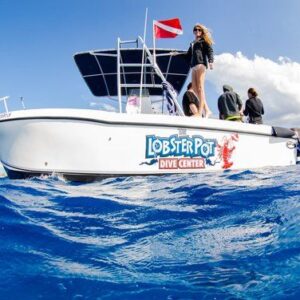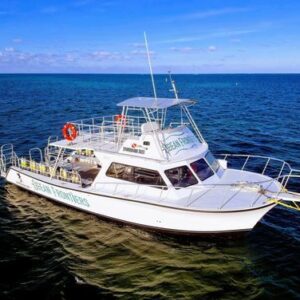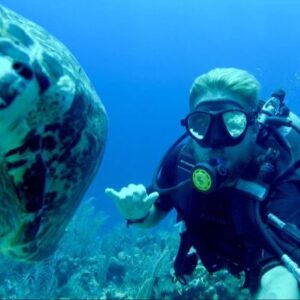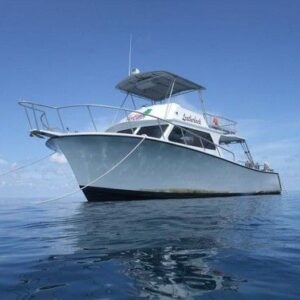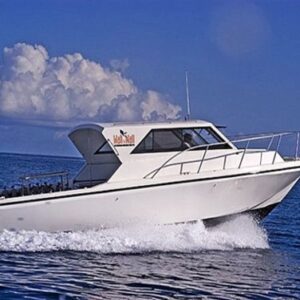An archipelago of three islands, this Caribbean destination is a must-do for avid divers. Grand Cayman is the most popular with visitors, thanks to terrific wall diving, plenty of resorts, exciting nightlife and the can’t-miss Stingray City. A visit to the secluded island of Cayman Brac offers more incredible wall diving as well as a famous Russian destroyer wreck. Want to get away from it all? Head to Little Cayman, the least developed of all the islands featuring dramatic, deep dives. But wherever you strap on a tank—don’t forget to treat yourself with a rum punch afterwards.
GETTING THERE
-
The Cayman Islands are a British Overseas Territory, meaning U.S. citizens require a passport to travel there. See TSA requirements for the most up to date information.
-
The main airport on the Cayman Islands is Owen Roberts International (GCM) in Grand Cayman. Cayman Brac has a small airport (Charles Kirkconnell Airport) and you can reach Little Cayman by daily inter-island flights. George Town in Grand Cayman is also a large port for cruise ships.
-
The best way to get around the Cayman Islands is by car—either a rental from the airport or a taxi. Reminder: Cars here drive on the left side of the road.
GOOD TO KNOW
-
The Cayman Islands are a British Overseas territory.
-
TIME ZONE: Eastern Standard Time.
-
PRIMARY LANGUAGES: English and Jamaican Patois.
-
CURRENCY: The Cayman Islands Dollar (KYD). U.S. dollars are accepted in many tourist areas.
-
PHONE AND INTERNET: Phone service is available from most U.S. phone carriers (you may need to activate international roaming). Internet is readily available including Wi-Fi at hotels and restaurants. The international calling code is +1 (345).
-
VOLTAGE: 120 (same as the U.S. and Canada).
-
Hurricane season runs from June to November in the Cayman Islands.
-
There are currently no travel health and safety notices in effect for the Cayman Islands.
DIVE CONDITIONS
-
Water temperatures range from 78 degrees Fahrenheit in winter to 86 degrees in summer.
-
Average water visibility is 60 to 100 feet but can be higher or lower depending on the weather.
-
WHEN TO GO
-
The Cayman Islands offers great diving conditions all year round.
-
The peak season for tourism is December to May.
-
WHAT YOU’LL SEE
-
Dramatic drops, kaleidoscopic coral and enchanting wreck dives make this one-stop shop a favorite with divers of all levels. It’s pretty obvious what you’ll find at Stingray City or Hammerhead Hill but just as magical are the turtles, groupers, barracudas, nurse sharks and myriad of tropical fish (think: angelfish, pufferfish, morays and more) that you’re likely to bump into. Oh, and did we mention that visibility is top-notch?
BEST SCUBA DIVING SITES IN THE CAYMAN ISLANDS
STINGRAY CITY, GRAND CAYMAN
This shallow sandbar (approximate depth is just 12 feet) on the western side of the island is ideal for beginner divers who can observe and interact with a group of friendly stingrays that flock here. You can also expect to see snappers, jacks, tangs and more.
MV CAPTAIN KEITH TIBBETTS, CAYMAN BRAC
Once a Russian warship, the Captain Keth was purposely sunk in 1996 and is now home to rainbow-hued sponges and a variety of marine life like moray eels and barracudas. While it’s possible to reach this wreck located on the northwest side of the island (“the Brac”) by a lengthy swim (approximately 600-feet), it’s much easier to hop on a boat. Don’t miss snapping a photo in front of the turret guns. Penetrating parts of the vessel should be attempted by advanced divers onlyf.
BLOODY BAY MARINE PARK, LITTLE CAYMAN
Located on the north side of the island, Bloody Bay features about two dozen fantastic dive sites with the best ones found along Bloody Bay Wall—a spectacular drop-off that starts at 20 feet and plummets to over 1,000 feet. Here, experienced divers can encounter a plethora of vivid coral (like bright yellow tube sponges) and exciting marine life (groupers, triggerfish and jacks, to name a few).
USS KITTIWAKE, GRAND CAYMAN
Sunk off the northern end of beautiful Seven Mile Beach, this former navy ship turned artificial reef is popular with divers of all levels (which is no surprise, considering that it was prepared with diving in mind). Those more advanced will enjoy gliding through the five levels of the ship including the mess hall and recompression chambers (you can even pose at the captain’s wheel) while novices can check out the exterior.
BEST SNORKELING IN THE CAYMAN ISLANDS
Thanks to shallow depths and calm waters, many of the most popular diving sites in the Cayman Islands are also great for snorkeling. For example, Stingray City is an excellent snorkeling site for swimmers of all ages while Bloody Bay’s Jackson Point and Nancy’s Cup of Tea (it already sounds fun, doesn’t it?) are also excellent snorkeling spots. And wrecks aren’t just for divers, either. The Cali wreck sits in shallow (20-feet) waters and lies just a short swim from George Town’s shores.
DISCOVER UNIQUE THINGS TO DO IN THE CAYMAN ISLANDS
THE MASTIC TRAIL, GRAND CAYMAN
Nature lovers will love this 2.3-mile hike located about a 50-minute drive from George Town that winds through a native mangrove swamp and an ancient (we’re talking 2-million-years-old) woodland. Expect to see exotic flora and fauna and lots of colorful birds on this 200-year-old footpath. Good hiking shoes recommended.
SEVEN MILE BEACH, GRAND CAYMAN
Shimmering turquoise waters and soft coral sands make this crescent-shaped stretch of beach postcard-perfect. So much so that it’s often dubbed the best beach in the entire Caribbean—not too shabby. Kickback at one of the casual beach bars (rum punch, please) and feel your stresses melt away.
THE CAYMAN TURTLE FARM
The world’s only green sea turtle farm gives a safe habitat for this endangered species and provides plenty of family fun for visitors.

